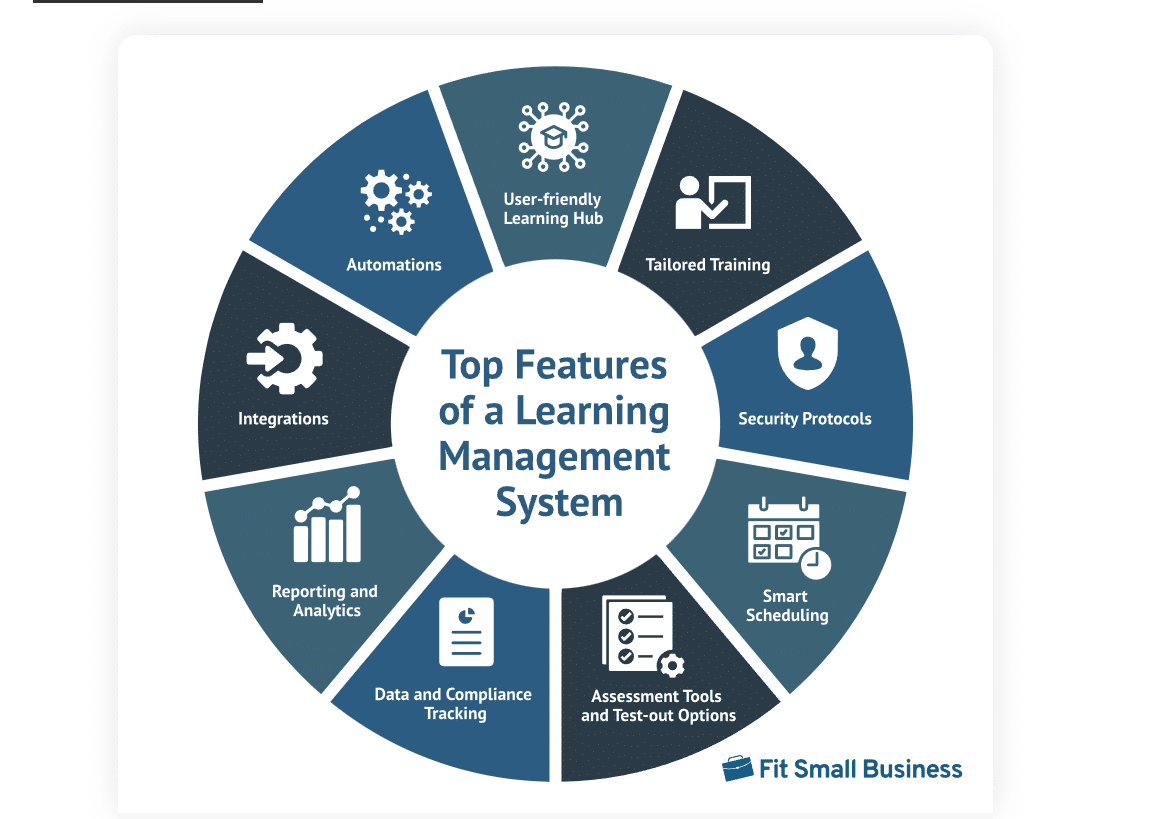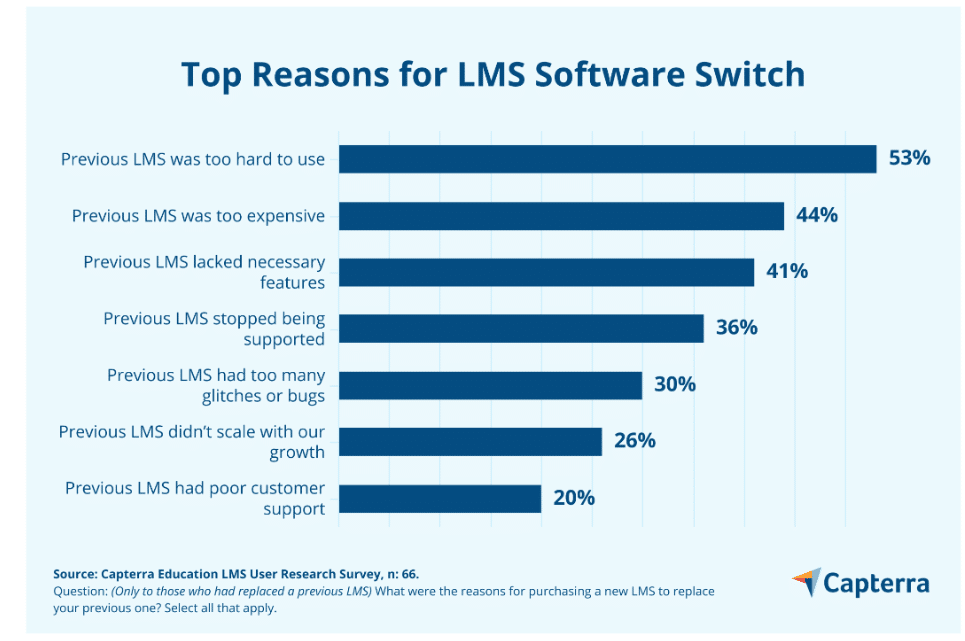In today’s dynamic educational landscape, traditional classrooms are facing a remarkable transformation, all thanks to the growing prominence of Learning Management Systems (LMS). The impact of Learning Management Systems in education is undeniable, providing a smart and efficient way for institutions to deliver personalized content and foster greater engagement among students.
Through Learning Management Systems, educators can customize learning materials, embrace diverse teaching models, and create an interactive learning environment that captivates students’ interest. Remarkably, statistics show that 98% of large companies currently use an LMS to deliver their training.
Let us now explore the countless possibilities that LMS opens up for educational institutions.
Reasons to Implement a Learning Management System

Learning Management Systems have gained popularity among educators due to its ease in delivering study materials, monitoring learner participation, and assessing performance. Educational institutes can leverage Learning Management Systems in various ways to impart training to learners, making it one of the most effective means of delivering online training. The flexibility and efficiency of LMS make it a valuable tool for enhancing the learning experience for both educators and students.
Here are some reasons why you need to implement learning management systems for schools:
1. Simplify Learning
For institutions struggling with the complexities of traditional learning methods, a learning management system can simplify and modernize the process. Its user-friendly interface and automation capabilities reduce the need for constant intervention, making it an effective tool for teachers and a compelling learning experience for students. It also enables institutions to offer remote training, accommodating those who are based in different locations.
2. Unlimited Customization Options & Easy Upgrades
A learning management system gives institutions the flexibility of unlimited customization, allowing teachers to tailor e-learning content to match specific institute’s needs or updates. They also facilitate quick and hassle-free content updates, an important feature for institutes that need to keep their staff updated with fast-paced institute changes or company-specific developments. The upgraded content gets automatically distributed to the learners or instructors, ensuring everyone is on the same page without any extra effort.
3. Tracking & Reporting with Robust Evaluation System
The ability to track learners’ progress and generate detailed reports can be a game-changer to identify performance gaps. With data-driven analysis, educators can identify struggling learners and tailor interventions, fostering a more inclusive and effective learning environment. Institutions can leverage robust evaluation systems of a learning management software to assess learner performance, identify skills gaps, and plan targeted goals. It allows for assessments before, during, and after a course, providing a holistic view of the learner’s progress.
4. Offer Centralized Learning
Centralized learning offered by LMS systems for schools ensures that all e-learning content is stored and managed in one place. This is particularly beneficial for schools or institutes who face challenges with data losses or inefficient learning processes. Centralization also allows for consistency in training materials, which is critical for institutions operating across multiple locations.

Top 5 Ways You Can Implement Learning Management System in Educational Institutions
There are thousands of Learning Management System (LMS) options available in the market today, each promising a wide range of functionalities and competitive pricing.
A staggering 63% of successful course creators reported that the online course platform they were using lacked essential features.
This raises a crucial question: How can you effectively leverage your LMS to ensure your users receive a seamless and enriching learning experience?
Here are 5 steps to implement a Learning Management System:
1. Define Your Objectives and Requirements
The journey towards an effective learning management system software implementation begins with a clear understanding of your institution’s objectives and specific requirements. Take the time to analyze and identify the features that align with your vision. Are you aiming to improve student retention, enhance leadership learning, streamline risk management, or increase student engagement? Clearly outline your goals to ensure the chosen learning management system caters precisely to your institution’s unique needs.
2. Conduct Thorough Research to Choose the Right Provider
Selecting the appropriate learning management system provider is the most important decision that requires meticulous research. Look beyond the flashy marketing and delve into the core capabilities of each platform. Seek recommendations from other educational institutions and read genuine reviews to gain insights into the strengths and weaknesses of various providers. Consider factors such as scalability, user-friendliness, technical support, and data security.
3. Test It and Gather Feedback
Before launching the full-scale implementation, consider a pilot test with a smaller group of users. This trial run will allow you to evaluate the LMS’s performance, identify any potential issues, and gather valuable feedback from users. Analyze the feedback carefully to make necessary adjustments and improvements to the system. This iterative approach will ensure that the final version of the learning system software is finely tuned to meet your institution’s requirements.
4. Promote Ongoing Training and Support
Implementing a learning management system is not a one-time event but an ongoing process. Continuous training and support are crucial to ensure that teachers and students can make the most of the platform’s capabilities. Offer workshops, webinars, and access to support resources to help users maximize their experience with the LMS. Encourage open communication channels to address any concerns promptly and foster a collaborative learning environment.
5. Fostering Continuous Improvement
Continuous improvement is about consistently evaluating and updating the learning management software based on feedback and changes in educational needs. Regular assessments help identify areas of the LMS that can be improved or updated. Keeping an open line for feedback from users, both students and staff, ensures the LMS stays relevant and effective. This process of constant review and refinement helps maintain a dynamic and efficient learning environment.
Conclusion
Implementing a Learning Management System (LMS) is a game-changer for modern education institutions. Streamline processes, deliver personalized content, and enhance learner outcomes with the right LMS. Take the leap into the future of education and training with a powerful and efficient learning management software solution.
Tired of managing complex educational processes manually? Choose Classe365’s learning management system for an interactive, immersive, and hassle-free experience. Our ERP for higher education enhances learning and streamlines administrative tasks, empowering educational institutions. Embrace hybrid learning, combining online and offline classes, for a flexible and personalized education.
Experience the future of learning with Classe365! Contact us today for a seamless transition to advanced education management.
